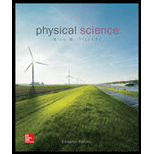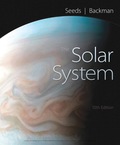
Physical Science
11th Edition
ISBN: 9780077862626
Author: Bill Tillery, Stephanie J. Slater, Timothy F. Slater
Publisher: McGraw-Hill Education
expand_more
expand_more
format_list_bulleted
Concept explainers
Textbook Question
Chapter 18, Problem 5PEB
What is the pressure, in N/m2, at a depth of 75 km in the continental crust?
Expert Solution & Answer
Want to see the full answer?
Check out a sample textbook solution
Chapter 18 Solutions
Physical Science
Ch. 18 - 1. The core of Earth is composed of
a. iron and...Ch. 18 - 2. The middle part of Earth's interior is
a....Ch. 18 - 3. The separation of materials that gave Earth its...Ch. 18 - 4. A vibration that moves through any part of...Ch. 18 - 5. The S-wave is a
a. longitudinal wave.
b....Ch. 18 - 6. Waves that occur where S- or P-waves reach the...Ch. 18 - 7. The three main areas of Earth’s interior are
a....Ch. 18 - 8. The boundary between the crust and the mantle...Ch. 18 - 9. The mantle is composed of
a. sulfides.
b....Ch. 18 - 10. Seismological studies suggests that the...
Ch. 18 - 11. Evidence from meteorite studies proposes that...Ch. 18 - 12. The layer in Earth where seismic waves sharply...Ch. 18 - 13. The layer that is broken up into plates that...Ch. 18 - 14. The name of the single large continent...Ch. 18 - 15. Records of the strength and directions of...Ch. 18 - 16. The chain of mountains found in the center of...Ch. 18 - 17. Long, deep, and narrow oceanic trenches are...Ch. 18 - 18. The theory that the lithosphere is composed of...Ch. 18 - 19. The plate boundary associated with the...Ch. 18 - 20. The movement of one plate under another plate...Ch. 18 - 21. Transform boundaries occur when
a. two plates...Ch. 18 - 22. What is the current theory about why the...Ch. 18 - 23. The seismic waves that cause the most damage...Ch. 18 - 24. Earth’s mantle has a chemical composition that...Ch. 18 - 25. From seismological data, Earth’s shadow zone...Ch. 18 - 26. The Mohorovicic discontinuity is a change in...Ch. 18 - 27. The oldest rocks are found in
a. continental...Ch. 18 - 28. The least dense rocks are found in
a....Ch. 18 - 29. The idea of seafloor spreading along the...Ch. 18 - 30. According to the plate tectonics theory,...Ch. 18 - 31. The presence of an oceanic trench, a chain of...Ch. 18 - 32. The presence of an oceanic trench with shallow...Ch. 18 - 33. The ongoing occurrence of earthquakes without...Ch. 18 - 34. The evidence that Earth's core is part liquid...Ch. 18 - 35. The surfaces of early planets in our solar...Ch. 18 - 36. The early Earth’s core is thought to have...Ch. 18 - 37. Indirect evidence that supports the theory of...Ch. 18 - 38. The oceanic crust is
a. thicker than the...Ch. 18 - 39. Seismic waves that do not travel through...Ch. 18 - 40. The fastest seismic wave is the
a. P-wave.
b....Ch. 18 - 41. Information about the composition and nature...Ch. 18 - 42. Primary information about the nature of the...Ch. 18 - 43. The asthenosphere is not defined as
a....Ch. 18 - 44. Earth’s magnetic field is thought to be...Ch. 18 - 45. Studies of the Mid-Atlantic Ridge provided...Ch. 18 - 46. Evidence that supports seafloor spreading does...Ch. 18 - 47. A geologic feature that was produced by...Ch. 18 - 48. Which type of plate boundary accounts for the...Ch. 18 - 49. Which type of plate boundary was responsible...Ch. 18 - 50. A famous transform boundary in the United...Ch. 18 - 51. Plate movement is measured by
a. reflected...Ch. 18 - 52. Islands that form when melted subducted...Ch. 18 - 1. Describe one theory of how Earth came to have a...Ch. 18 - 2. Briefly describe the internal composition and...Ch. 18 - 3. What is the asthenosphere? Why is it important...Ch. 18 - 4. Describe the parts of Earth included in the (a)...Ch. 18 - 5. What is continental drift? How is it different...Ch. 18 - 6. Rocks, sediments, and fossils around an oceanic...Ch. 18 - 7. Describe the origin of the magnetic strip...Ch. 18 - 8. Explain why ancient rocks are not found on the...Ch. 18 - 9. Describe the three major types of plate...Ch. 18 - 10. What is an island arc? Where are they found?...Ch. 18 -
11. Briefly describe a model that explains how...Ch. 18 - 12. Briefly describe the theory of plate tectonics...Ch. 18 - 13. What is an oceanic trench? What is the...Ch. 18 - 14. Describe the probable source of all the...Ch. 18 - 15. The northwestern coast of the United States...Ch. 18 - 16. Explain how the crust of Earth is involved in...Ch. 18 - 1. Why are there no active volcanoes in the...Ch. 18 - 2. Describe cycles that occur on Earth's surface...Ch. 18 - 3. Discuss evidence that would explain why plate...Ch. 18 - 4. Analyze why you would expect most earthquakes...Ch. 18 - 1. The rate at which the temperature increases...Ch. 18 - 2. Based on a geothermal gradient of 15°C/km, what...Ch. 18 - Prob. 3PEBCh. 18 - 4. What is the pressure, in N/m2, at the depth of...Ch. 18 - 5. What is the pressure, in N/m2, at a depth of 75...Ch. 18 - 6. What is the pressure, in N/m2, at the base of...Ch. 18 - 7. Wood floating in water can demonstrate how the...Ch. 18 - 8. A teacher would like to demonstrate the...Ch. 18 - 9. A survey of a mid-oceanic ridge determined the...Ch. 18 - 10. GPS stations on two separate plates have...Ch. 18 - 11. What is the geothermal gradient along a...Ch. 18 - 12. What are the subduction direction and slope of...Ch. 18 - 13. What are the subduction direction and slope,...Ch. 18 - 14. Earthquake data from a subduction zone are...Ch. 18 - 15. The North American Plate is moving west at a...
Additional Science Textbook Solutions
Find more solutions based on key concepts
How is the charging time for a capacitor correlated with the initial current? That is, if the initial current i...
Matter and Interactions
Check Your Understanding If the line spacing of a diffraction grating d is not precisely known, we can use a li...
University Physics Volume 3
A container ship is 240m long and 22m wide. Assume that the shape is like a rectangular box. How much mass does...
Fundamentals Of Thermodynamics
The Rankine temperature scale (abbreviatedR) uses the same size degrees as Fahrenheit, but measured up from abs...
An Introduction to Thermal Physics
Explain what happens to the energy carried by light that it is dimmed by passing it through two crossed polariz...
College Physics
56. Global Positioning System. Learn more about the global positioning system and its uses. Write a short repo...
The Cosmic Perspective (8th Edition)
Knowledge Booster
Learn more about
Need a deep-dive on the concept behind this application? Look no further. Learn more about this topic, physics and related others by exploring similar questions and additional content below.Similar questions
- What is the drift rate of the Pacific plate over the Hawaiian hot spot?arrow_forwardIf you wanted to live where the chances of a destructive earthquake were small, would you pick a location near a fault zone, near a mid ocean ridge, near a subduction zone, or on a volcanic island such as Hawaii? What are the relative risks of earthquakes at each of these locations?arrow_forwardWhich type of seismic wave cannot pass through Earths core? What does that indicate about the composition of the core?arrow_forward
- Explain briefly how the following phenomena happen on Earth, relating your answers to the theory of plate tectonics A. earthquakes B. continental drift C. mountain building D. volcanic eruptions E. creation of the Hawaiian island chainarrow_forwardThe Hawaiian-Emperor chain of undersea volcanoes is about 7500 km long, and the Pacific plate is moving 9.2 cm a year. How old is the oldest detectable volcano in the chain? What has happened to older volcanoes in the chain?arrow_forwardName the four major regions of the Earth, from outermost to innermost.arrow_forward
arrow_back_ios
arrow_forward_ios
Recommended textbooks for you
 An Introduction to Physical SciencePhysicsISBN:9781305079137Author:James Shipman, Jerry D. Wilson, Charles A. Higgins, Omar TorresPublisher:Cengage Learning
An Introduction to Physical SciencePhysicsISBN:9781305079137Author:James Shipman, Jerry D. Wilson, Charles A. Higgins, Omar TorresPublisher:Cengage Learning AstronomyPhysicsISBN:9781938168284Author:Andrew Fraknoi; David Morrison; Sidney C. WolffPublisher:OpenStax
AstronomyPhysicsISBN:9781938168284Author:Andrew Fraknoi; David Morrison; Sidney C. WolffPublisher:OpenStax Foundations of Astronomy (MindTap Course List)PhysicsISBN:9781337399920Author:Michael A. Seeds, Dana BackmanPublisher:Cengage Learning
Foundations of Astronomy (MindTap Course List)PhysicsISBN:9781337399920Author:Michael A. Seeds, Dana BackmanPublisher:Cengage Learning

An Introduction to Physical Science
Physics
ISBN:9781305079137
Author:James Shipman, Jerry D. Wilson, Charles A. Higgins, Omar Torres
Publisher:Cengage Learning

Astronomy
Physics
ISBN:9781938168284
Author:Andrew Fraknoi; David Morrison; Sidney C. Wolff
Publisher:OpenStax

Foundations of Astronomy (MindTap Course List)
Physics
ISBN:9781337399920
Author:Michael A. Seeds, Dana Backman
Publisher:Cengage Learning

A Level Physics – Ideal Gas Equation; Author: Atomi;https://www.youtube.com/watch?v=k0EFrmah7h0;License: Standard YouTube License, CC-BY